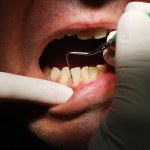
Periodontal disease refers to issues relating to or affecting the tissues surrounding the neck and root of a tooth, It is a significant oral health problem for people with Down syndrome. It can be a cause of tooth loss and has a number of contributing factors, which includes poor oral hygiene.
Antimicrobial agents like chlorhexidine have been shown to have some benefits but a key issue is the system of delivery used. For example, rinsing may not may not work if the person has a difficulty with swallowing or is unable to spit out the rinse, but it can also be applied using a spray bottle or a toothbrush.
The researchers in this study wanted to look at the effects of different application of chlorhexidine, either as a gel (1%) or varnish (1% and 40%)
Method
What they did was to carry out a single blind, crossover, randomised trial. A crossover methodology refers to a longitudinal study where over the period of the study, each participant receives (or does not receive) the intervention of interest in a random sequence
They worked with a group of 27 people with Down syndrome over a 24 month period who were referred to the Dublin Dental University Hospital.
They applied two different concentrations of chlorhexidine varnish (1% and 40%) 3-monthly and 6-monthly.
There was a positive control phase where no chlorhexidine varnish was used. All regimes for participants though were supplemented with professional prophylaxis 6-monthly and chlorhexidine gel (1%) applied at home on a daily basis.
They used a number of standard measures of periodontal health that have been tested for validity and reliability. Measurements were taken at the beginning of the study as baseline measures, at 3-months or 6-months intervals and finally at the end of the study period following the cessation of treatments.
They also administered a questionnaire to carers to get information on the attitudes to the different regimes used and any impact on quality of life.
Findings
What they found was significantly lower mean ‘pocket probing depths’ which refers to gaps between the margin of the gum tissue and the tooth) for the control phase compared to those who received 3-monthly application of chlorhexidine varnish (1%).
They found significantly lower mean gingival bleeding index (or gum bleeding) for those who received 6-monthly applications of chlorhexidine varnish (40%), compared to the control phase.
For the people who received 6-monthly chlorhexidine varnish (40%) there were interesting findings on the quality of life measures from the questionnaires as they showed statistically significantly higher eating scores than during the control phase.
Conclusion and comment
Oral hygiene is a major issue for people with learning disabilities and for people with Down syndrome there may be additional issues relating to swallowing difficulties and difficulties in accessing teeth and rinsing and spitting.
This study tried to look at any differences in different concentrations and application methods for antimicrobial agents using a randomised methodology. However, the trial as single blind and was quite small, with only 27 participants.
What they found however were few, significant differences between concentration, formulation or frequency of application of chlorhexidine on clinical measures of periodontal disease.
They suggest that from their findings, it may be that Chlorhexidine gel (1%) applied at home daily (along with 6-monthly professional prophylaxis) could be effective in maintaining periodontal health in individuals with Down syndrome.
The information from the quality of life scores does add to the richness of the findings however, as they found that whilst Chlorhexidine varnish (40%) applied 6-monthly offered potential benefits in terms of periodontal health, it did cause some eating difficulties.

Chlorhexidine gel (1%) applied at home daily could be effective in maintaining periodontal health
Link
L Freedman, J Nunn, W Thomas, N Claffey, A Kell, Preventive strategies to improve periodontal health in people with Down syndrome, Journal of Disability and Oral Health 12, 2, 59 – 67 [abstract]
Key words: Chlorhexidine, Down syndrome, periodontal disease, quality of life


No experience of the chlorhexidine varnish but care should be taken wth daily use of chlorhexidine gel and more especially the mouthwash as it can lead to staining of the teeth.
The use of chlorhexidine in any form should be to augment toothbrushing not replace it.